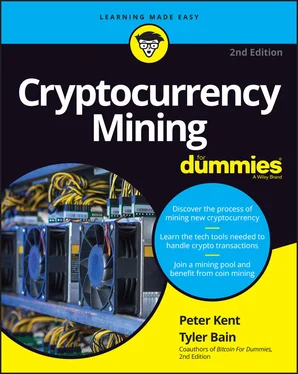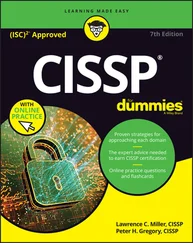A Proof of Work task can be almost anything, as long as it is a complex task that takes a more or less predictable amount of work and results in an answer that is quickly and easily verifiable.
Primecoin, for example, has a Proof of Work task that involves finding chains of prime numbers that are then stored in the blockchain and available for use by mathematicians for, well, whatever it is they do with prime numbers. In the case of Bitcoin, the Proof of Work task has no practical use beyond securing transactions in the blockchain. Here’s how Bitcoin’s Proof of Work task functions.
The miner is looking for a number that matches a particular criteria; it must be a number that is below a certain target level (that target is one of the items stored in the block header).
The number is created by hashing the block header, creating in effect a digital fingerprint. (For more on hashing, see Chapter 1).
Now, the hash is a 256-digit binary number, expressed as a 64-digit hexadecimal number. Here’s an example:
000000000000000015ecd7feb009048fb636a18b9c08197b7c7e194ce81361e9
Each block has a target number. The hash of the block header has to be equal to or less than the target number. Look at the preceding hash. It starts with 16 zeros and is actually a winning hash from some time ago. The more zeros at the start of the number, the smaller the number, and the harder to find, and over time difficulty typically goes up. Now, the target number is even smaller (this example, with 16 zeros at the start, is from some time ago). It begins, at the time of writing, with 19 zeroes.
The smaller the target number, the harder the task, right? Because fewer numbers are below a small number than a large number, and we need a hash that is less than the target.
So the miner hashes the block header. But every time you hash a piece of data, you’re going to get the same result, right? So if the miner hashes the block header and finds that it’s not less than the target, they have to change the block header. Well, the nonce is a piece of data in the block header. It is simply a number. The miner changes the nonce and hashes again. This time, the result of the hash will be different. Chances are, it’s still not less than the target number, so the miner changes the nonce, hashes again, and checks the number, and so on.
Now, the magic of the hashing algorithm is that you can’t predict which nonce will get you the result you want. The only way to find the result you want is to try, and try, and try again — thousands of times — until you get a hash that is less than the target. And if you do this before anyone else, you win!
This task is hugely difficult. A 64-digit hexadecimal number has this many possible variations (whatever this number is called!): 39,400,000,000,000,000,000,000,000,000,000,000,000,000,000,000,000,000,000,000,000,000,000,000,000,000,000,000,000,000,000,000,000,000,000,000,000,000,000. So the vast majority of hashes, purely based on chance, are going to exceed the target.
Say that you’re the lucky miner who first finds a nonce that, when added to the block header, results in a hash that is below the target number — you win!
You announce to the network that you’ve won. You create a block header for the block, which includes a timestamp, a software version number, the hash of the previous block, and the hash of the block’s transaction’s Merkle tree root. (Never mind, to successfully mine you don’t have to know about Merkle trees.) You then send out your candidate block , with its block header and the header’s hash, onto the network, so other nodes can check it. And check it they do.
A block doesn’t get added to the blockchain unless it’s been verified. To make sure you’ve won, the nodes hash the block header and check the result against the existing block header’s hash. Remember, the Proof of Work task is very difficult, but easily verified, so it can be quickly seen that you have won the contest. The nodes add your block to the blockchain, and the contest resets and begins again. Oh, and you get the block reward — the transaction fees and block subsidy — assigned to your address in the new block.
That’s mining!
So who typically wins these contests? It’s a combination of both chance and computing power. Each time you add a nonce and hash the block header, there’s a mathematically defined chance of winning. It’s low, but possible. Hey, you might win on the first try! (You might, but it’s just not very likely.)
How then do you increase your chances? You add a nonce and rehash over and over and over, millions of times. Each time you hash, it’s like buying a lottery ticket. So the more lottery tickets you buy, the better your chances. That means the more powerful your mining rigs — the more calculations they can carry out — the more chances you have.
This process may all sound very complicated but the hard work is carried out by your mining rig and your node software. You’re not going to be sitting down every ten minutes with paper and pencil hashing the block header! You set up the appropriate hardware and software and let it run.
All of these preset rules and system guidelines are baked into the software that runs the Bitcoin blockchain. A block contains around 2,000 transactions (it varies slightly depending on how much information is in each transaction). One block is added every ten minutes, more or less. In order to maintain this block emission rate, the software has to adjust its difficulty rules every now and then — every 2,016 blocks, in fact. If it’s taking less than ten minutes for each block, on average — because more computing power is being used for mining, as more miners and mining rigs come online — then the target number will be proportionally reduced, to increase the difficulty. If it’s taking more than ten minutes, though (as the price of Bitcoin drops, fewer people mine), then the target number is increased, reducing the difficulty. Also, every 210,000 blocks — around every four years — the block subsidy is halved. At the time of writing, the subsidy is 6.25BTC, but sometime in 2024, it will drop to 3.125BTC.
Конец ознакомительного фрагмента.
Текст предоставлен ООО «ЛитРес».
Прочитайте эту книгу целиком, купив полную легальную версию на ЛитРес.
Безопасно оплатить книгу можно банковской картой Visa, MasterCard, Maestro, со счета мобильного телефона, с платежного терминала, в салоне МТС или Связной, через PayPal, WebMoney, Яндекс.Деньги, QIWI Кошелек, бонусными картами или другим удобным Вам способом.












